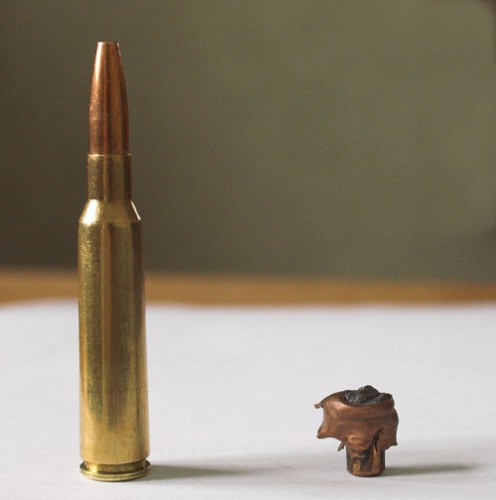6.5×55 Swedish before and after expanding. The long base and small expanded diameter show that this is a bullet designed for deep penetration on large game. The bullet in the photo traveled more than halfway through a moose before coming to rest, performing as designed.
And apparently they\’re all banned by the Hague Convention.



























































it is one of my personal fav rounds. 🙂
I have a serious hardon for all 6.5mm/.260cal rounds.
Now that Magpul has released a .308 PMAG, I feel a LaRue OSR .260 Remmy in my future.
Though for deep penetration a barnes or solid turned bronze bullet is the way to go.
If it’s hollow…then fill it w/more gunpowder!!!
MASSIVE INTERNAL TRAUMA FTW
In after random gun nuts have started ejaculating over the pic.
Someone with more knowledge help me out. I thought the whole point of hollow tip rounds was to trade the penetration normal (or even armor piercing) rounds have in exchange for a wider, more damaging wound. Yet the description of this round focuses exclusively on the penetration potential, and barely talks about the wound size. Am I missing the point?
Completely unnecessary for any civilian to own one of these.
A traditional hollow point as found in pistol ammo is designed to mushroom out very quickly. This causes all the inertia in the round to dump that energy VERY quickly.
A Hollowpoint Boitbail (HPBT) round has a very small hollowpoint on it. Like pinprick small. Rounds like this have a very high ballistic coefficient, which means they stay in the air longer.
The round in this pic is something like the original Dum Dum round. A spitzer (pointed) round with the tip removed.
There is a hague or geneva convention article that says something about no military units can use ammunition designed to expand. This allows HPBT rounds (JAG has certified as other governments).
The current trend in most military small arms ammunition designed to kill people vs penetrate armor is fragmenting. The early 5.45×39 for the AK74 were dubbed the poision arrow because there was a very large hollow section in the front of the round which caused the projectile to yaw dramatically upon entering denser materials (like air to flesh)
@...WistfulD: Well, i don;t think there isn’t any specific ideal round characteristic for every situation. Hunting big game, you want both high penetration, in order to reach vital organs, *and* a large wound channel, order to maximize damage.
But in some settings, you might want massive energy transfer, (take down power) not necessarily penetration, and use rounds that expand very quickly, in order to lower the risk of over penetration and avoid possibly injuring third parties.
Against possibly armored combatants, high penetration rounds might be necessary, while against unarmored combatants in a combat scenario, you want to be able to carry more rounds, which means smaller rounds, but because they are smaller, you will need spall (fragmenting) or yaw (tumbling) rounds to maximize damage, as Nimbo suggested.
Every scenario, ROE, laws, etc usually requires a complex blend of round characteristics for the right combination of knock down power or penetration or fragmentation, energy, speed, range ect. It is not always a simple matter of penetration vs wound channel size…
I don’t got them blanks, I got them hollow bullet tips
More specifically, hollow point and lead nosed bullets are banned for use citizens of nations who have signed the Hague Convention. Against other nations, guerrillas, terrorists, plain old criminals, all bets are off. In practical application, the U.S. commonly uses approved bullets for all military engagements.